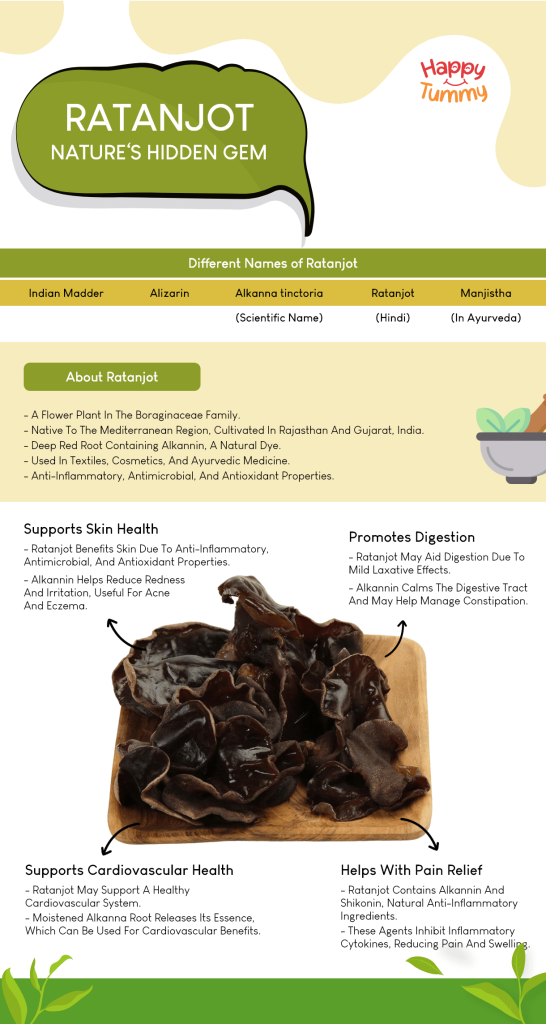Table of Contents
With the world moving towards the adoption of natural methods to achieve health and beauty, the benefits of the ancient Indian herb Ratanjot (commonly referred to as Indian Madder or Alizarin) are gaining widespread acceptance due to its unparalleled qualities.
Well-known and used in treatment for centuries, this reddish, beet-like root is rich in everything people could hardly imagine.
Whether it is a case of enhancing overall health or providing any form of relief, Ratanjot has proven its worth in a variety of ways by facilitating and maintaining wellness in a manner that was only recently understood by modern science.
In this blog, we will discuss Ratanjot, often referred to as the secret treasure of nature, as a means of promoting a healthier state of mind and increased physical activity in the natural healing process.
Regardless of whether you seek to enhance your well-being or find out more about the incredible botanical, the positive aspects of Ratanjot will undoubtedly leave you impressed.
About Ratanjot
Ratanjot (Alkanna tinctoria) is a flower plant that belongs to the Boraginaceae family.
It is native to the Mediterranean region, but it has also been cultivated in India, particularly in the arid states of Rajasthan and Gujarat, where it thrives in the hot, semi-arid climate.
The plant boasts a deep red root that contains a compound called alkannin, which is responsible for its colourful nature. It is a natural dye that is popularly used in making textiles, cosmetics, and in Ayurvedic treatments.
The Ratanjot root tastes light and bitter with an earthy flavour. It is traditionally used in folk medicine, where it was believed to have anti-inflammatory, antimicrobial, and antioxidant effects contributing to the overall health and better skin condition.

Important Consideration
Though Ratanjot is used as a food and possesses several medicinal benefits, it is usually taken in little quantities as it is said to have bitterness and strong effects.
It is also utilised more commonly in the medical field than it is in typical cooking cuisine. ,
You must always consult a doctor when you want to include Ratanjot in your diet or health routine to check whether it will be safe and appropriate for your individual conditions.
Different Names of Ratanjot
Ratanjot is known by different names in various regions and cultures. Some of the popular names of Ratanjot are:
- Indian Madder
- Alizarin
- Alkanna tinctoria (Scientific Name)
- Ratanjot (Hindi and common regional name in India)
- Ratanjodi
- Chirayta (In some parts of India)
- Manjistha (In Ayurveda)
They are interchangeably referred to as a medicinal plant, a dye plant, or a botanical species, depending on the region and context.
Health Benefits of Ratanjot
As a long-standing traditional medicine, Ratanjot is a multi-potent plant with numerous health benefits and can be applied to produce a variety of positive effects. The key benefits of it are the following:
#1 Supports Skin Health
Ratanjot is significantly more beneficial for skin beauty due to its anti-inflammatory, antimicrobial, and antioxidant properties.
The root contains a substance called alkannin, which has been demonstrated to control redness and irritation, making it a reason why the element can be used in managing conditions like acne and eczema.[1]
It may help fight bacteria and prevent infections, leading to healthier skin due to its antibacterial properties.
In addition, antioxidants found in Ratanjot help the skin resist oxidative stress, a phenomenon associated with free radicals that accelerates ageing and causes skin cell destruction.
Ageing is a natural process; no ingredient can prevent the ageing process. Nevertheless, due to its high antioxidant content, ratanjot may help delay the progression of wrinkles associated with ageing and preserve skin quality.
Research has revealed that alkannin also stimulates wound healing; therefore, it is a natural treatment method for minor wounds or burns.[2]
Do not apply Ratanjot to your skin without consulting a dermatologist first, as it can worsen skin conditions if you are allergic to it.
#2 Promotes Digestion
The mild laxative properties of Ratanjot may significantly contribute to its ability to facilitate the digestive process. Alkannin, found in the root, has been seen to pacify the digestive tract.
It may help handle constipation by stimulating bowel movement. Additionally, Ratanjot’s antioxidant properties support a healthy gastrointestinal system by aiding in the breakdown of food, thereby enhancing gut health and metabolism.[3]
#3 Supports Cardiovascular Health
Ratanjot (Alkanna root) may help support a healthy cardiovascular system. It is possible to use it by moistening the root in water to release its essence, which can be used.
Alkanna roots also have a hypotensive effect on the cardiovascular system, which may be effective in managing higher blood pressure.
The antioxidants found in Ratanjot are also significant because they could destroy the harmful free radicals within the body. These free radicals are either waste products of metabolism or exogenous, and it has been discovered that Ratanjot possesses an antioxidant activity that can potentially maintain the well-being of the entire heart.[4]
#4 Helps with Pain Relief
Ratanjot is a natural anti-inflammatory that has alkannin and shikonin, and can be of great benefit to the body in eliminating pain and inflammation.
These agents may work by blocking the production of inflammatory cytokines, which are responsible for causing pain and swelling throughout the body. [5]
Ratanjot, when used as a topical medicine or in low doses, can help manage pain and is preferred over others since it acts on inflammatory processes.
Besides other competencies, its analgesic properties are not only pain-relieving values, but also result in increased mobility and comfort, and simultaneously enhance the overall quality of life.[6]
Also, it is essential to remember that Ratanjot is not always the sole product that could help with pain management, and it is recommended to seek the advice of medical personnel.
How do we take or use Ratanjot?
Ratanjot is taken in small doses, whether in a tea mixture with other herbs or as a topical preparation in creams or ointments.
Depending on the purpose, it can be applied to the skin or ingested, optionally.
It is always recommended to consult with a healthcare provider before using it, especially when you are introducing it to your routine.
Before introducing any new ingredient into your diet, it is essential to exercise caution, as excessive consumption or overuse can have adverse effects.
Bottom Line
Ratanjot is a powerful herb, and its benefits have been appreciated in traditional medical history.
It is also antimicrobial, anti-inflammatory, and antioxidant; thus, it may help manage issues with unhealthy skin, pain, and digestive tract disorders. ,
Ratanjot brings the body to a state of calmness and rhythm by its cleansing properties, improving circulation, and promoting the immune system.
The extensive property, containing both alkannin and shikonin, establishes a natural system that increases the overall wellness level and makes the body resistant to harmful toxins and inflammation.
Nonetheless, even though it is a treasure house of health benefits, we must not forget that the general means of dealing with health concerns include maintaining a reasonably well-balanced diet, engaging in routine fitness exercises, and having healthy lifestyle preferences.
Always be sure to consult with a physician before any positive effort of trying new herbs or supplements, especially on the grounds of pre-existing illnesses or medication.
Frequently Asked Questions
Ratanjot, also known as Alkanna tinctoria, is the scientific name for a flowering plant native to the Mediterranean region. It is cultivated widely in parts of India, particularly in Rajasthan and Gujarat, and has a history of centuries of use in traditional medicine and the natural dyeing industry.
Ratanjot has had numerous applications in traditional medicine. It is commonly found in most Ayurvedic healing and herbal treatments. The plant root is commonly applied either in the form of a powder or an infusion to alleviate some ailments.
Ratanjot, yes, is also called Alizarin, the name of the compound occurring in its roots. The deep red colour of Ratanjot is due to Alizarin, a natural dye that is historically used in the dyeing of textiles as well as cosmetics.
Ratanjot is generally safe and is taken in small quantities. That said, you should discuss it with a medical practitioner and consider it when adding it to your daily schedule, at least when pregnant, lactating, and under medication. Too much of it can lead to relatively mild side effects, including stomach pain or rash in a few individuals.
















